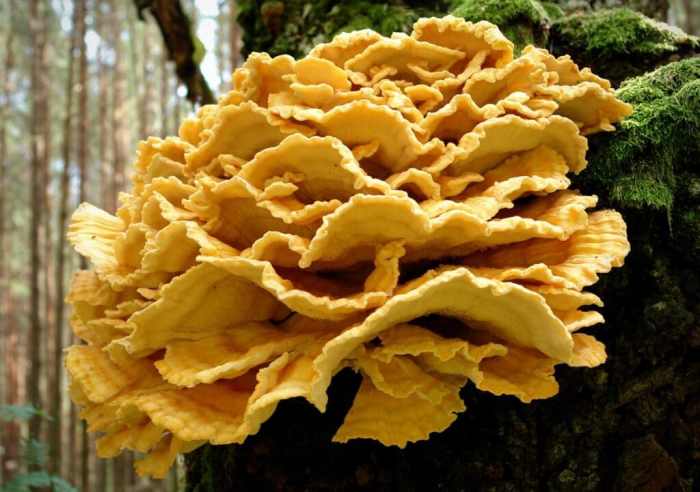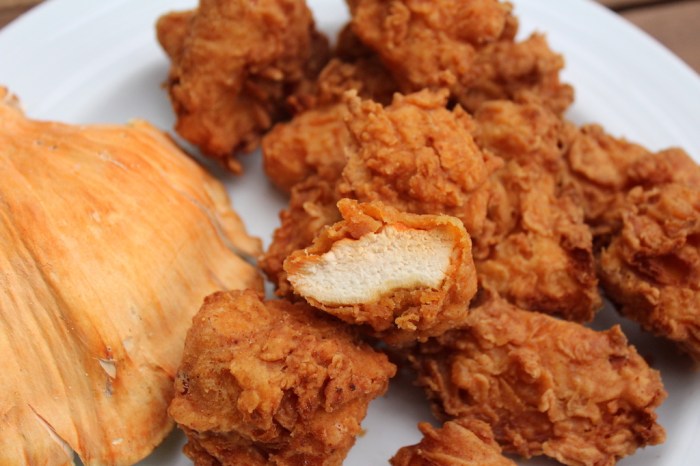
Chicken of the woods recipe – Chicken of the Woods, a vibrant orange fungus, is a culinary treasure waiting to be explored. Its earthy flavor and meaty texture make it a versatile ingredient, perfect for sautéing, roasting, or grilling. In this guide, we’ll delve into the world of Chicken of the Woods, from its identification to preparation and storage.
Identify and Describe Chicken of the Woods

Chicken of the woods (Laetiporus sulphureus) is a large, edible mushroom with a distinctive appearance and flavor. It is commonly found in North America and Europe, growing on the trunks and branches of dead or dying oak trees.
Chicken of the woods has a bright orange or yellow color, with a velvety texture. It grows in large clusters, often weighing several pounds. The flesh is white and firm, with a slightly chewy texture. When cooked, it has a mild, chicken-like flavor.
Culinary Significance
Chicken of the woods is a popular culinary mushroom, prized for its unique flavor and versatility. It can be used in a variety of dishes, including soups, stews, stir-fries, and salads. It can also be grilled, roasted, or fried.
Nutritional Value
Chicken of the woods is a good source of protein, fiber, and vitamins. It is also low in calories and fat. One cup of cooked chicken of the woods contains:
- Calories: 25
- Protein: 3 grams
- Fiber: 2 grams
- Vitamin C: 10% of the Daily Value
- Potassium: 5% of the Daily Value
Methods for Cooking Chicken of the Woods

Chicken of the Woods is a versatile mushroom that can be cooked in various ways. Each method offers unique advantages and disadvantages, allowing you to customize your culinary experience. Here are some popular methods for cooking Chicken of the Woods:
Sautéing
Sautéing involves cooking the mushroom in a pan with a small amount of oil or butter over medium heat. This method is quick and easy, allowing you to develop a nice golden-brown crust on the outside while keeping the interior tender and juicy.
Sautéed Chicken of the Woods is perfect for adding to pasta dishes, omelets, or salads.
Roasting
Roasting Chicken of the Woods in the oven brings out its earthy flavors and caramelizes the edges slightly. Preheat your oven to 400°F (200°C) and toss the mushrooms with olive oil, salt, and pepper. Roast for 15-20 minutes, or until golden brown and tender.
Roasted Chicken of the Woods can be served as a side dish or added to soups and stews.
Grilling
Grilling Chicken of the Woods imparts a smoky flavor and gives it a slightly charred exterior. Brush the mushrooms with olive oil and season with your favorite spices. Grill over medium heat for 5-7 minutes per side, or until tender and slightly charred.
Grilled Chicken of the Woods is perfect for burgers, sandwiches, or as an appetizer.
Pickling
Pickling Chicken of the Woods preserves its unique flavor and texture while adding a tangy twist. Slice the mushrooms thinly and combine them with a pickling solution made from vinegar, water, sugar, and spices. Let the mushrooms pickle for at least 24 hours before enjoying.
Pickled Chicken of the Woods is a great addition to salads, sandwiches, or as a condiment.
Creating a Delicious Chicken of the Woods Recipe
Preparing Chicken of the Woods is a culinary adventure that yields delectable dishes. This guide will provide a step-by-step walkthrough of a delectable recipe, along with variations and modifications to suit your palate.
Ingredients, Chicken of the woods recipe
To craft this culinary masterpiece, you’ll need:
- 1 pound fresh Chicken of the Woods, cleaned and torn into bite-sized pieces
- 1 tablespoon olive oil
- 1/2 onion, chopped
- 2 cloves garlic, minced
- 1/2 cup dry white wine (optional)
- 1 cup vegetable broth
- 1/2 cup heavy cream
- 1/4 cup grated Parmesan cheese
- Salt and pepper to taste
- Fresh parsley, for garnish
Preparation
Follow these steps to create your culinary delight:
- In a large skillet, heat the olive oil over medium heat. Add the onion and garlic and cook until softened.
- Add the Chicken of the Woods to the skillet and cook until browned on all sides.
- Deglaze the pan with white wine, if using, and let it simmer until reduced by half.
- Add the vegetable broth and bring to a boil. Reduce heat and simmer for 15 minutes, or until the Chicken of the Woods is tender.
- Stir in the heavy cream and Parmesan cheese and cook until the sauce has thickened.
- Season with salt and pepper to taste.
- Garnish with fresh parsley and serve over pasta, rice, or your favorite side dish.
Variations and Modifications
To cater to your preferences, here are some variations and modifications to consider:
- For a richer flavor, use butter instead of olive oil.
- Add a pinch of dried thyme or oregano to the skillet for added aroma.
- Substitute the vegetable broth with chicken broth for a more intense flavor.
- For a creamy and indulgent sauce, use a mixture of heavy cream and sour cream.
- Top the dish with toasted breadcrumbs or crispy onions for added texture.
Nutritional Information and Health Benefits: Chicken Of The Woods Recipe

Chicken of the Woods is not only a culinary delight but also a nutritional powerhouse. It is an excellent source of protein, providing essential amino acids for muscle growth and repair.
Additionally, it is rich in dietary fiber, which promotes satiety, aids digestion, and helps regulate blood sugar levels. Vitamin-wise, Chicken of the Woods is a good source of vitamins B and C, which support energy production, immune function, and antioxidant defense.
Antioxidant Properties
Chicken of the Woods contains a variety of antioxidants, including ergothioneine, a unique antioxidant that has been shown to protect cells from oxidative damage and reduce the risk of chronic diseases such as cancer and heart disease.
Immune System Support
The beta-glucans present in Chicken of the Woods have been found to enhance immune function by stimulating the production of white blood cells and other immune cells that fight off infections.
Storing and Preserving Chicken of the Woods

Proper storage and preservation techniques are crucial to maintain the freshness and flavor of Chicken of the Woods. By following the right methods, you can extend its shelf life and enjoy its delicious taste for a longer duration.
Refrigeration: Fresh Chicken of the Woods can be refrigerated for up to 5 days. Store it in a paper bag or wrapped in a damp paper towel to maintain moisture. Avoid using plastic bags as they trap moisture and promote spoilage.
Freezing: Freezing is an excellent way to preserve Chicken of the Woods for several months. Cut it into smaller pieces, blanch them in boiling water for 2-3 minutes, and then drain and freeze them in airtight containers. Frozen Chicken of the Woods can be stored for up to 6 months.
Drying: Drying Chicken of the Woods is a traditional method of preservation that removes moisture and intensifies its flavor. Slice it thinly, spread it on a baking sheet, and dry it in an oven at the lowest setting (around 150°F) for several hours or until crispy.
Dried Chicken of the Woods can be stored in an airtight container at room temperature for up to a year.
Final Summary

From its nutritional value to its unique flavor profile, Chicken of the Woods is a culinary delight that will elevate your cooking adventures. Whether you’re a seasoned chef or a novice in the kitchen, this guide has everything you need to create delicious and unforgettable dishes with this forest delicacy.
Essential FAQs
What does Chicken of the Woods taste like?
It has a savory, meaty flavor with a slightly earthy undertone.
Is Chicken of the Woods poisonous?
No, it is not poisonous when cooked properly.
How can I store Chicken of the Woods?
Store in the refrigerator for up to 3 days, or freeze for longer storage.





